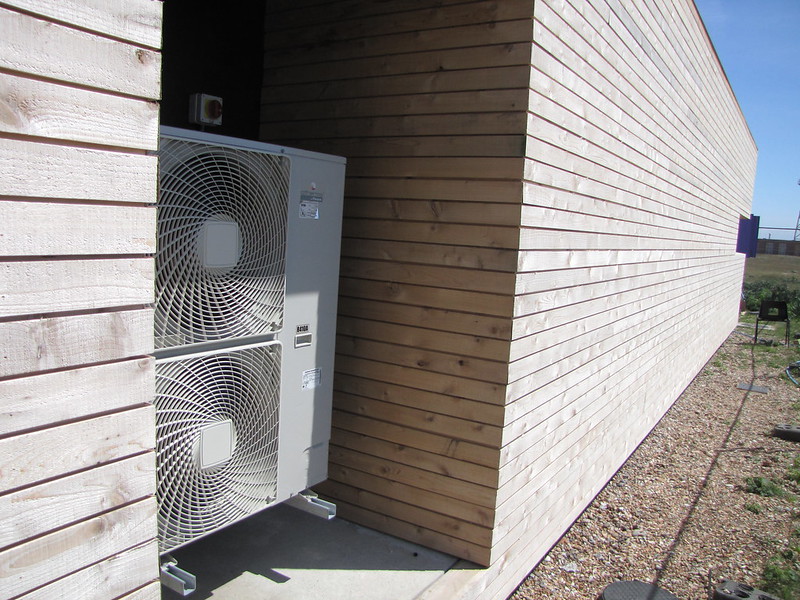Air source heat pumps (ASHPs) are not a renewable energy source themselves, but they can be part of a renewable energy system. ASHPs utilize renewable energy from the air, which is an abundant and sustainable resource. They extract heat from the outside air and transfer it indoors, requiring minimal electricity for operation, making them highly energy efficient. By reducing energy consumption, buildings can significantly lessen their carbon footprint and contribute to a greener future.
Understanding the Renewable Potential of Air Source Heat Pumps
ASHPs can be powered by electricity sourced from clean energy technologies such as windmills, solar panels, and hydropower dams, making them suitable for use with green energy. As the electrical grid incorporates more renewable energy sources, the environmental impact of ASHPs will further decrease.
Renewable Energy Sources Powering Air Source Heat Pumps
-
Wind Power: Wind turbines generate electricity by harnessing the kinetic energy of wind. When ASHPs are powered by wind-generated electricity, they become part of a renewable energy system, as wind is an abundant and sustainable resource.
-
Solar Power: Solar photovoltaic (PV) panels convert sunlight into electricity, which can be used to power ASHPs. This creates a renewable energy system, as the sun is a limitless and renewable energy source.
-
Hydropower: Hydroelectric dams generate electricity by converting the potential energy of water into electrical energy. When ASHPs are powered by hydroelectric power, they become part of a renewable energy system, as water is a renewable resource.
-
Geothermal Energy: While not a direct power source for ASHPs, geothermal energy can be used to generate electricity, which can then be used to power ASHPs, creating a renewable energy system.
Efficiency and Environmental Benefits of Air Source Heat Pumps
-
Energy Efficiency: ASHPs are highly energy-efficient, as they extract heat from the outside air and transfer it indoors, requiring minimal electricity for operation. This can lead to significant energy savings and reduced greenhouse gas emissions compared to traditional heating systems.
-
Reduced Carbon Footprint: By reducing energy consumption and relying on renewable energy sources, ASHPs can significantly lower the carbon footprint of buildings, contributing to a more sustainable future.
-
Adaptability to Renewable Energy Grid: As the electrical grid incorporates more renewable energy sources, the environmental impact of ASHPs will continue to decrease, making them an increasingly attractive option for sustainable heating and cooling.
-
Versatility in Climate Conditions: ASHPs can operate effectively in a wide range of climates, from mild to cold, making them a viable option for various geographical regions.
-
Reduced Reliance on Fossil Fuels: By utilizing renewable energy sources, ASHPs can help reduce the reliance on fossil fuels for heating and cooling, contributing to the transition towards a more sustainable energy system.
Limitations and Considerations
-
Climate Dependency: The efficiency of ASHPs can be affected by outdoor temperature, with reduced performance in colder climates. This may require supplementary heating sources in some regions.
-
Electricity Grid Emissions: The environmental benefits of ASHPs are directly tied to the emissions of the electricity grid that powers them. In regions with a high reliance on fossil fuels for electricity generation, the environmental impact of ASHPs may be less significant.
-
Upfront Costs: The initial installation cost of ASHPs can be higher compared to traditional heating and cooling systems, which may be a barrier for some homeowners and building owners.
-
Noise Levels: Outdoor units of ASHPs can generate noise, which may be a concern for some homeowners or in densely populated areas.
-
Maintenance Requirements: ASHPs require regular maintenance, such as cleaning the outdoor unit and checking refrigerant levels, to ensure optimal performance and efficiency.
Conclusion
While air source heat pumps are not a renewable energy source themselves, they can be an integral part of a renewable energy system. By utilizing renewable energy sources to power ASHPs, buildings can significantly reduce their carbon footprint and contribute to a more sustainable future. As the electrical grid continues to incorporate more renewable energy sources, the environmental benefits of ASHPs will only continue to grow, making them an increasingly attractive option for sustainable heating and cooling.

